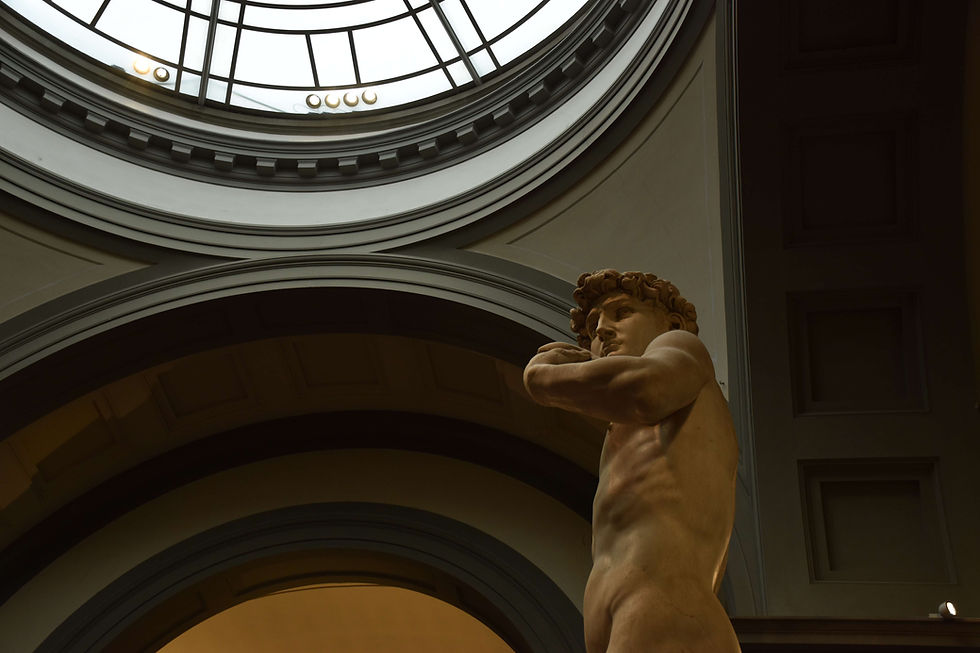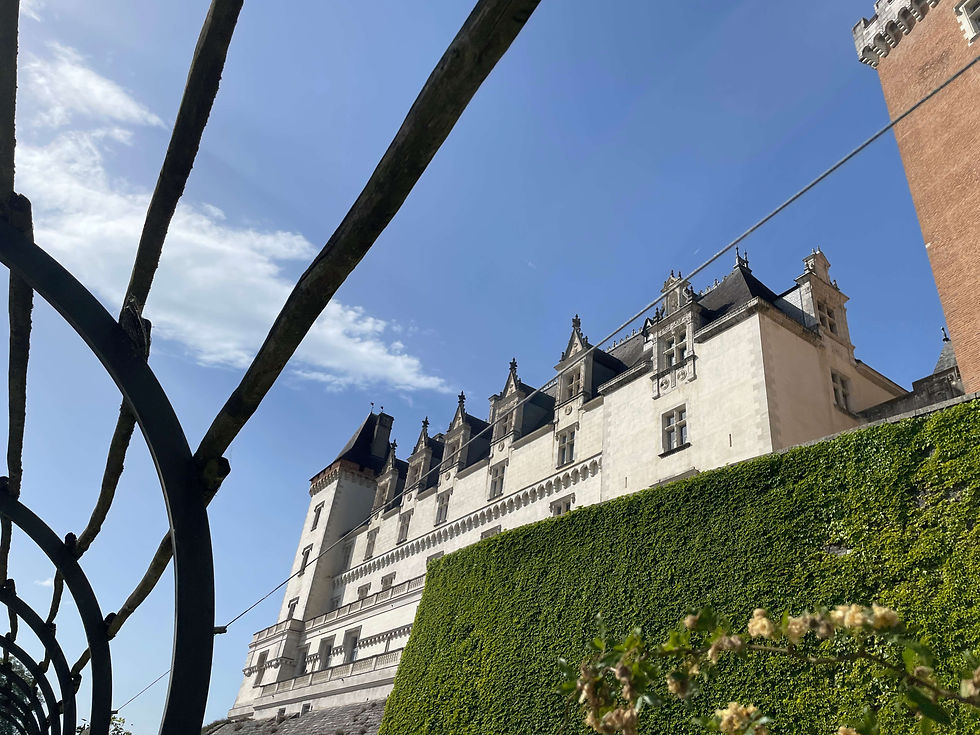Art as the Soul of Florence
- Autumn Mayer
- May 5
- 7 min read
An Essay from Travel Writing
If Rome is a city of history, then Florence is equally a city of art. You need only Google the city’s name to discover that it is primarily known for its strong connection to Renaissance art and architecture, from Brunelleschi’s dome crowning the Duomo to Michelangelo’s David under the bright skylight of the Galleria dell’Accademia. Excited to see some of the greatest art of the world, I arrived in Florence on the third leg of my spring break trip to Italy. It was 10:30 p.m. by the time the train pulled into the station, so my first impression of the city was empty tram tracks and narrow sidewalks in the dark. The rest had to wait until morning. My friend Allison and I had Uffizi Galleries tickets for 8:15 a.m. We set out first thing through the winding streets of Florence’s center, the buildings all wood and stucco painted various shades of brown and cream. The elegant arcades of the art museum’s exterior were lined with statues.
Once inside, we started at the beginning of the museum’s U shape with 13th- and 14th-century art, including Giotto’s Virgin and Child Enthroned, the painting that heralded the shift from Medieval to Early Renaissance art. Impersonal gold backgrounds would become lush landscapes; tranquil faces, each the same as the last, would become unique expressions of emotion. I have never liked Medieval art, and that is why. As beautiful as bright colors and gold filigree are, that beauty, lacking humanity, can only carry so far. The museum presented Botticelli next, Primavera and The Birth of Venus both shrouded with crowds. Then Da Vinci, Raphael, Michelangelo, the great masters dotted throughout less familiar artworks, the history of art and culture permeating each room. While better than the Medieval, there was still something academic about these paintings, their air a little cold, a little distanced. We descended to the first floor. Many of the tourists from the beginning of the circuit fell off or fell behind, bored with so many hours of art after the names they knew became fewer and farther between. The rooms were a dark warren, only the art illuminated. I turned a corner, and there she was.
The Venus of Urbino is a 1538 Titian painting. The setting is an upper-class home in 16th-century Venice: tall windows offer a sunset view, tapestries adorn the stone walls, graceful tiles recede in perspective. Two maids remove a wedding gown from a decorative chest. A forest velvet curtain halfway shields a red chaise longue with rumpled white sheets and fluffy pillows. A little dog curls at the end of the bed, a symbol of fidelity. It takes study to note these details, because the first thing you see is Venus, in the guise of a young noble about to be wed, reclining on the chaise. The blending of her skin tones betrays an infinite softness. She stares directly at the viewer, her eyes following you around the room. Her gaze is flirtatious but also confrontational; you cannot escape her, and you do not want to. If I had been alone, I would have sat there and not moved for hours. This, I find, is real beauty. The kind of beauty that collapses time and distance, and melts attention. Words fail, and it becomes injustice to attempt them. All that remains is to look as long as you are able.

As it was, we continued on through a couple more rooms before arriving in the Caravaggio section. Caravaggio, who exerted a strong influence on the development of Baroque painting, gained many followers of his chiaroscuro-based style, collectively known as Caravaggisti or Caravaggesques. It is clear to even the untrained eye that Caravaggio possessed something that none of his followers were ever able to reproduce: a darkness, a vibrancy, a reality that only he could master. Yet, one young woman came the closest to matching his genius, even surpassing him in certain ways. Artemisia Gentileschi, the daughter of Caravaggio’s friend Orazio, was one of the few women in art history to make a name for herself as a successful, independent painter. Her early life was painfully marked by her rape, perpetrated by Agostino Tassi, and the subsequent trial against him. The trial lasted nine months, from March to November 1612. Gentileschi was questioned and tortured at length to “verify” the truth of her statements. One of her most famous works is the 1620 painting Judith Slaying Holofernes.
Judith Slaying Holofernes is displayed in the same room as Caravaggio’s Medusa, within direct line of sight as you transition from one room into the next. The painting was criticized as being too “virile,” and Gentileschi even had a difficult time collecting the payment she was promised for the commission. Yet this virility—the muscles in Judith’s arms and shoulders as she saws her sword through Holofernes’s neck, the intent way her maidservant pins the Assyrian general to the bed—is exactly what makes the painting so magnetic, and so much better than Caravaggio’s own version, Judith Beheading Holofernes from 1598. The background is almost entirely black. The white bed is stained dark with Holofernes’s blood. Judith, who wears Gentileschi’s features, bears a determined, unafraid expression as she cuts Holofernes’s head from his body; with this action, Gentileschi also slays Agostino, as she painted Holofernes with his face. The power of Gentileschi’s story moves by osmosis into her work, and this—along with the rich color palette and unapologetic gore—is what makes the painting so entirely striking: beauty dressed in violence, violence expressed as beauty. It was once again with regret that I moved on.

Two days later, Allison and I rose early to wait in the ticket line at the Galleria dell’Accademia, arriving at the museum that houses Michelangelo’s David around 7:30 a.m. We hadn’t been able to get timed tickets ahead of time because they had sold out weeks in advance, before we planned our trip. This is a testament to the fascination still held for The David. Once again, we experienced Florence’s streets early in the morning, before any locals or other tourists were awake. There was no one at the unassuming entrance to the museum, so we circled the block to make sure we were actually in the right place. Back at the original doors, we settled in to wait the forty-five minutes until the museum opened. I bought a latte to fend off the spring chill that still hovered in the air. We talked for a while with a couple from Michigan on their belated honeymoon. Closer to 8:15 a.m., the employees, who I had seen joking around at the café, arrived to set up stanchions and direct the line. The non-ticketed line was let in after the 8:15 group at around 8:30—the Italians are even less concerned with the concept of time than the French. With a last “good luck” to the Michigan couple, we shot off into the chaos of the security and ticket lines, then bolted for The David.
“[I]t cannot be denied that this work has carried off the palm from all other statues, modern or ancient, Greek or Latin; no other artwork is equal to it in any respect, with such just proportion, beauty and excellence did Michelangelo finish it,” wrote Giorgio Vasari, biographer and author of Lives of the Most Excellent Painters, Sculptors, and Architects. Even this high praise doesn’t do the statue enough justice. We entered the rotunda at the back of the museum, where The David is displayed, and the room was flooded with bright daylight. The skylights were designed specifically for The David, to illuminate the soft curve of his torso, the muscles of his thigh accented by his contrapposto posture, the barely noticeable lines of the sling over his shoulder. He is fourteen feet tall, made of marble no other artist wanted to touch, and took Michelangelo three years, between 1501 and 1504, to complete. Contrary to artistic tradition, he is portrayed before he slays Goliath—relaxed but ready, at the height of his concentration—not after, standing triumphantly over the severed head. His right hand and head are slightly too big for his body, possibly to denote that David beat Goliath due to cleverness and faith rather than because of strength, possibly because the statue was originally meant to be displayed eighty feet up on the wall of the Duomo. When he was completed, he was too perfect, too beautiful, and it was decided that he must be displayed in the Piazza della Signoria in front of the Palazzo Vecchio, for all to see.
The room was crowded with tourists, but The David towered over them all. I was able to walk all the way around him, taking in every vein, snapping pictures, trying to ingrain him in my memory. And as before, with all the other beautiful artworks I experienced in Florence, I had to tear myself away. The soul of Florence is in its art, just as art is the soul of the world.

Works Cited
https://www.nationalgallery.org.uk/artists/artemisia-gentileschi. Accessed 6 Apr. 2025.
https://artsandculture.google.com/project/artemisia-gentileschi. Accessed 6 Apr. 2025.
https://www.musee-jacquemart-andre.com/en/artemisia. Accessed 6 Apr. 2025.
https://www.uffizi.it/en/artworks/judith-beheading-holofernes. Accessed 29 Apr. 2025.
“Le terrible procès de la peintre Artemisia Gentileschi contre son violeur : le martyre
d’une icône du féminisme.” Beaux Arts, 7 Aug. 2024,
gentileschi-contre-son-violeur-le-martyre-dune-icone-du-feminisme/.
Accessed 29 Apr. 2025.
Accessed 29 Apr. 2025.
“The Uffizi.” Uffizi Galleries, https://www.uffizi.it/en/the-uffizi. Accessed 29 Apr. 2025.
https://www.uffizi.it/en/artworks/venus-urbino-titian. Accessed 29 Apr. 2025.
.jpg)



Comments